

Artist’s illustration depicting phosphine molecules in Venus’ atmosphere. On Earth, and as far as scientists know, phosphine can only be produced either by microbes or artificially in labs. Image via ESO/ M. Kornmesser/ L. Calçada/ NASA/ JPL-Caltech/ Royal Astronomical Society/ Attribution: CC BY 4.0.
This article accidentally found its way into Google searches before the embargo upon it was lifted today. EarthSky deeply apologizes for any confusion or disappointment caused by this breach.
Most of us are familiar with this quote from Sir Arthur Conan Doyle, who created the character Sherlock Holmes:
Once you eliminate the impossible, whatever remains, no matter how improbable, must be the truth.
Those words might be apropos this week, as scientists announce an incredible discovery: tentative evidence for microbial life within the atmosphere of Venus.
As space fans know, Venus at its surface is scorching and inhospitable, hot enough to melt lead. It’s one of the last places you’d expect to find any kind of life. But the hints of tiny Venusian microbes come not from the planet’s surface, but rather from its atmosphere, where conditions can be reasonably Earth-like.
It should be noted that this new discovery is not yet proof of life on Venus. But the researchers make a compelling case.
The exciting findings come from scientists in the U.S. and U.K., at the Massachusetts Institute of Technology (MIT), Cardiff University, University of Manchester and others. Jane Greaves of Cardiff University led the study. The Royal Astronomical Society (RAS) provided an online press briefing for journalists via Zoom last week, with three of the researchers there to discuss results. The RAS also issued a news release. The scientific were published in the prestigious, peer-reviewed journal Nature Astronomy today, September 14, 2020.
For as long as we’ve known about conditions on the planet Venus, thanks in large part to visiting space probes, Venus has always been considered one of the least likely places to support life as we know it. With scorching temperatures hot enough to melt lead and crushing air pressure at the surface – not to mention large amounts of sulfuric acid in its clouds – Venus is far from welcoming.
Some scientists, however, have speculated that life might be possible higher up in the atmosphere, where temperatures and pressures are Earth-like in a temperate zone. It is in this zone that scientists made the discovery.
What did the researchers find?
Simply put, they found a gas in Venus’ atmosphere that should not be there and that, on Earth, is considered a conclusive biosignature. It’s a very stinky gas called phosphine. As far as scientists know, there are only two ways to produce phosphine, either artificially in a lab, or by certain kinds of microbes that live in oxygen-free environments. Since there aren’t any alien labs on Venus (that we know of), that leaves microbes.
The researchers made the detection using the James Clerk Maxwell Telescope in Hawaii and the ALMA telescope in Chile.
Researchers from MIT had previously published studies showing that if phosphine was to ever be found on another rocky planet, it would be a sure sign of life there. That is why this discovery is so provocative.
But before announcing this tantalizing evidence, the researchers, of course, wanted to try to rule out other explanations. They considered and tested multiple scenarios where this gas might be produced without life, but as they acknowledge, they came up empty. Clara Sousa-Silva at MIT, whose career specialty is studying phosphine, said in a statement:
It’s very hard to prove a negative. Now, astronomers will think of all the ways to justify phosphine without life, and I welcome that. Please do, because we are at the end of our possibilities to show abiotic processes that can make phosphine.
Finding phosphine on Venus was an unexpected bonus! The discovery raises many questions, such as how any organisms could survive. On Earth, some microbes can cope with up to about 5% of acid in their environment, but the clouds of Venus are almost entirely made of acid.
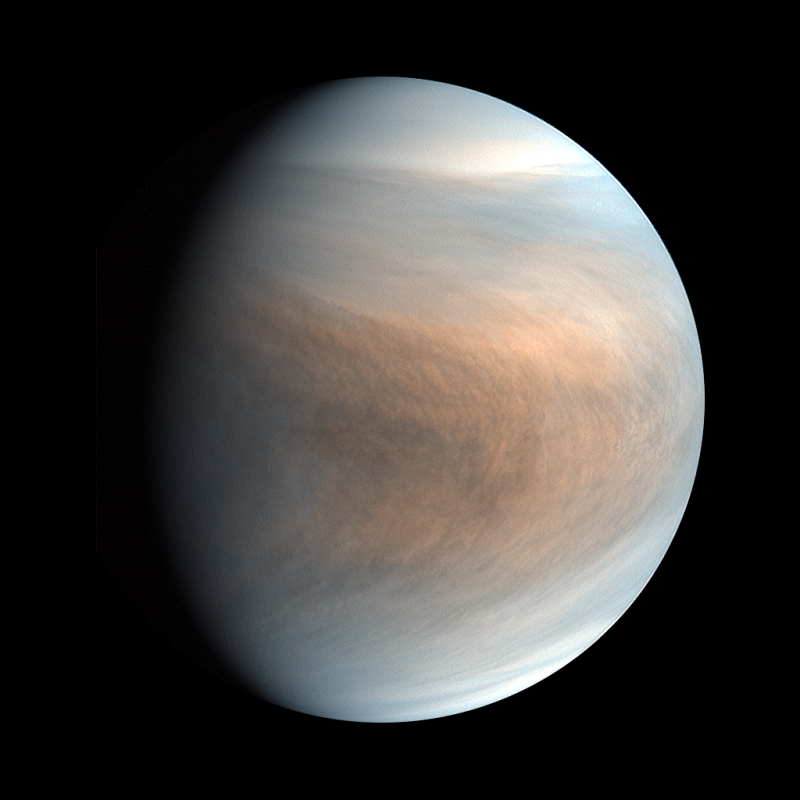
False-color view of Venus (to bring out details) from Japan’s Akatsuki orbiter. Image via JAXA/ ISAS/ Akatsuki Project Team/ Royal Astronomical Society/ Attribution: CC BY 4.0.
Co-author Janusz Petkowski added:
This means either this is life, or it’s some sort of physical or chemical process that we do not expect to happen on rocky planets.
We really went through all possible pathways that could produce phosphine on a rocky planet. If this is not life, then our understanding of rocky planets is severely lacking.
That’s a pretty definitive statement to make.
Greaves said:
This was an experiment made out of pure curiosity, really, taking advantage of JCMT’s powerful technology, and thinking about future instruments. I thought we’d just be able to rule out extreme scenarios, like the clouds being stuffed full of organisms. When we got the first hints of phosphine in Venus’ spectrum, it was a shock!
The researchers processed the data for six months before becoming convinced the phosphine was really there. According to Anita Richards, of the U.K. ALMA Regional Centre and The University of Manchester:
To our great relief, the conditions were good at ALMA for follow-up observations while Venus was at a suitable angle to Earth. Processing the data was tricky, though, as ALMA isn’t usually looking for very subtle effects in very bright objects like Venus.

Jane Greaves at Cardiff University, who led the phosphine study. Image via Cardiff University.
Greaves said:
In the end, we found that both observatories had seen the same thing, faint absorption at the right wavelength to be phosphine gas, where the molecules are backlit by the warmer clouds below.
William Bains at MIT led the work on trying to assess other natural ways to make phosphine on Venus. Some ideas included sunlight, minerals blown upwards from the surface, volcanoes, or lightning, but none of these could make anywhere near enough of it. These kinds of sources could only make, at most, one ten thousandth of the amount of phosphine that the telescopes saw. So something is producing a lot more of the gas. According to Paul Rimmer at Cambridge University, terrestrial organisms would only need to work at about 10% of their maximum productivity in order to produce the amount of phosphine found on Venus.
On Earth, phosphine is produced by microbes that don’t need oxygen. They absorb phosphate minerals, add hydrogen, and ultimately expel phosphine gas. Since Venus has virtually no oxygen in its atmosphere, that’s another similarity suggesting the gas actually is coming from microbes.
Since Venus is much too hot at its surface for any known earthly microbes, they must be in its atmosphere. There is a temperate region, between 48 and 60 kilometers (about 30 to 37 miles) above the surface, where temperatures range from 30 to 200 degrees Fahrenheit (roughly 0 to 90 degrees Celsius). That’s the habitable zone on Venus, and just happens to be where the phosphine was found. As Petkowski noted:
This phosphine signal is perfectly positioned where others have conjectured the area could be habitable.
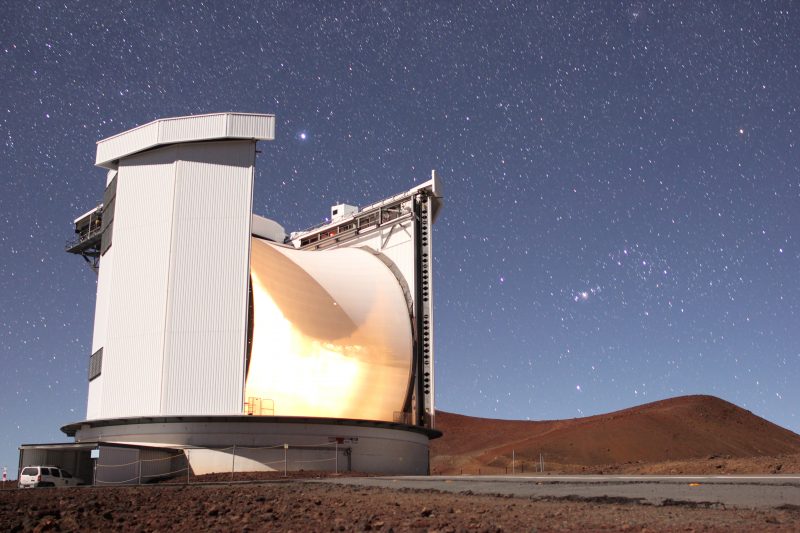
The James Clerk Maxwell Telescope in Hawaii was the first to detect the phosphine signature in the Venusian atmosphere. Image via Will Montgomerie/ EAO/ JCMT/ Royal Astronomical Society/ Attribution: CC BY 4.0.
The researchers will now be following up with more telescope observations, including to look for other gases that might be associated with life. They also to want to see if there are daily or seasonal variations in the signal that would suggest activity associated with life. Emma Bunce, president of the Royal Astronomical Society, advocates for return missions to Venus, saying:
A key question in science is whether life exists beyond Earth, and the discovery by Professor Jane Greaves and her team is a key step forward in that quest. I’m particularly delighted to see U.K. scientists leading such an important breakthrough, something that makes a strong case for a return space mission to Venus.
Petkowski said:
You can, in principle, have a life cycle that keeps life in the clouds perpetually. The liquid medium on Venus is not water, as it is on Earth.
Scientists also think that Venus used to be much more habitable a few billion years ago, and even had oceans before the runaway greenhouse effect took hold. According to Sousa-Silva:
A long time ago, Venus is thought to have had oceans, and was probably habitable like Earth. As Venus became less hospitable, life would have had to adapt, and they could now be in this narrow envelope of the atmosphere where they can still survive. This could show that even a planet at the edge of the habitable zone could have an atmosphere with a local aerial habitable envelope.
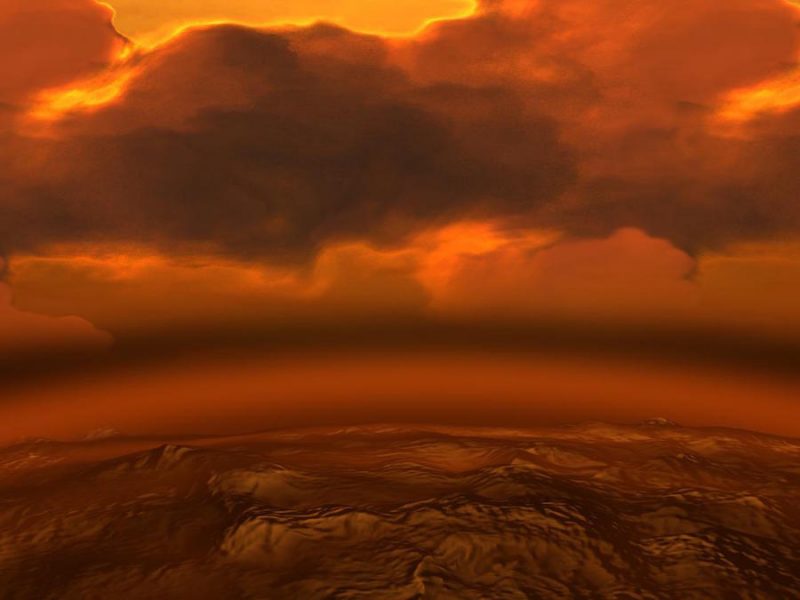
The thick clouds that perpetually cover Venus’ surface are highly acidic, but there is a region where temperatures and pressures are quite Earth-like, making it possible for microorganisms to exist there. Image via ESA/ Astronomy.
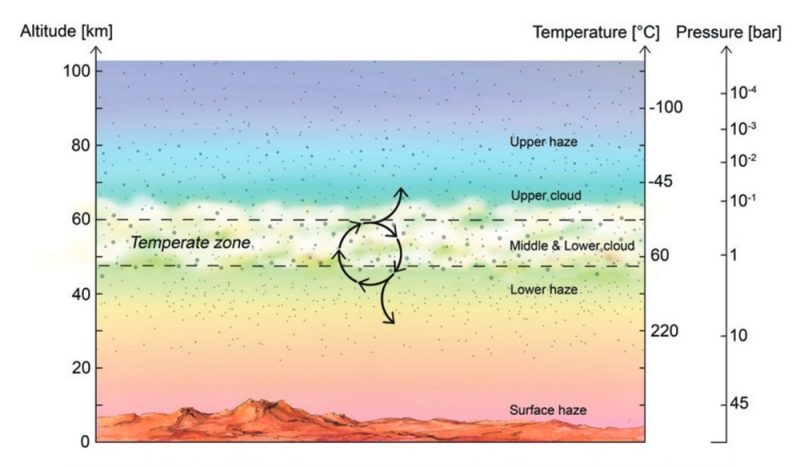
The temperate zone in Venus’ atmosphere where temperatures and pressures are more habitable for life. Image via Seager et al. (2020)/ Astronomy.
This habitable zone in the cloud decks might be the last refuge for Venusian microorganisms. That’s an incredible – if difficult to believe – thought, but if the scientists are right, then it is one of the most amazing discoveries in history. How amazing would it be to know that not only are we not alone, but that we had neighbors on the closest planet to Earth all this time? From Souva-Silva’s 2019 article in Scientific American about phosphine:
Life as we know it is likely only one island in the vast archipelago of possibilities for biology. Our galaxy has a huge diversity of stars, and orbiting them are planets of every kind. Earth alone has given rise to billions of species. So, it is not a big leap to think that life itself can arise in a large array of unexpected forms, which fill their atmospheres with strange molecules such as phosphine. One day we might detect phosphine in one of these atmospheres. These would not be fun places for us; frankly, we might find them disgusting. On the other hand, the residents of these planets would probably find us disgusting too (a problem for interplanetary diplomacy to overcome). Nonetheless, if we find phosphine on a rocky planet in the habitable zone, where it has no false positives, we will have found life.
There, she is talking about finding phosphine in the atmosphere of an exoplanet orbiting another star. But the same basic scenario would apply to other rocky planets in our own solar system. Despite its hellish conditions on the surface, Venus does reside near the edge of our sun’s habitable zone, the region around a star where temperatures could allow liquid water to exist.
Last month, another study discussed in Astronomy magazine and elsewhere, showed how microbes could theoretically exist in Venus’ atmosphere by finding refuge inside drops of sulphuric acid that also contain some water. They would cycle through different layers of the atmosphere, never reaching the ground, and survive the most extreme conditions by transitioning into a temporary dormant state.
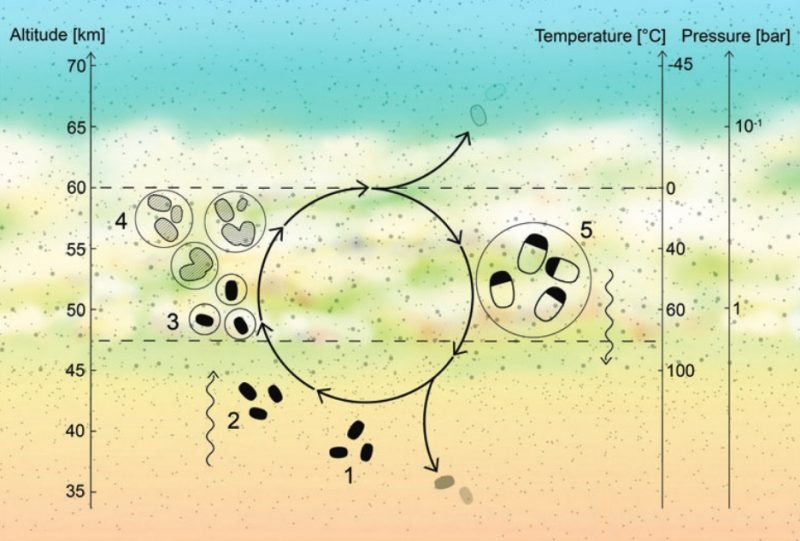
A proposed life cycle for microbes in Venus’ atmosphere. (1) Dehydrated microbes survive in a vegetative state in Venus’ lower haze layer. (2) The spores are lifted by updrafts into the habitable cloud layer. (3) Once encapsulated by liquid, the spores become metabolically active. (4) These microbes divide, and the droplets grow through coagulation. (5) The droplets grow large enough that they sink through the atmosphere, where they begin to evaporate due to higher temperatures, prompting microbes to transform into spores that float in the lower haze layer. Image via Seager et al. (2020)/ Astronomy.
While the discovery is surprising, scientists have speculated for years that microbial life might exist in Venus’ atmosphere. It might even explain, as postulated by some scientists, the unusual dark streaks that somehow absorb ultraviolet light, called “unknown absorbers.” Those patches have been found to be composed of tiny – but still unknown – particles about the size of bacteria on Earth.
Even Carl Sagan suggested that life could be possible in Venus’ atmosphere. But due to the acidic clouds, any microbial life would likely be quite different from any on Earth. Other scientists, including David Grinspoon, have written about the possibility of life in Venus’ clouds before as well. Some of the best articles are at Eos, Astrobiology Magazine, Space.com and Sky & Telescope. Grinspoon also talked about it on Magellan TV and for Breakthrough Discuss. Now, it seems they may just have been right all along.
Again, this is not quite proof of life on Venus yet, but it is tantalizingly close. It will be very interesting to see what future follow-up observations show.
Bottom line: Is there microbial life in the atmosphere of Earth’s closest neighbor, Venus? An international team of astronomers has found tentative but highly compelling evidence.
Via Massachusetts Institute of Technology
Via University of Manchester
Via Royal Astronomical Society
from EarthSky https://ift.tt/3khd9Cg


Artist’s illustration depicting phosphine molecules in Venus’ atmosphere. On Earth, and as far as scientists know, phosphine can only be produced either by microbes or artificially in labs. Image via ESO/ M. Kornmesser/ L. Calçada/ NASA/ JPL-Caltech/ Royal Astronomical Society/ Attribution: CC BY 4.0.
This article accidentally found its way into Google searches before the embargo upon it was lifted today. EarthSky deeply apologizes for any confusion or disappointment caused by this breach.
Most of us are familiar with this quote from Sir Arthur Conan Doyle, who created the character Sherlock Holmes:
Once you eliminate the impossible, whatever remains, no matter how improbable, must be the truth.
Those words might be apropos this week, as scientists announce an incredible discovery: tentative evidence for microbial life within the atmosphere of Venus.
As space fans know, Venus at its surface is scorching and inhospitable, hot enough to melt lead. It’s one of the last places you’d expect to find any kind of life. But the hints of tiny Venusian microbes come not from the planet’s surface, but rather from its atmosphere, where conditions can be reasonably Earth-like.
It should be noted that this new discovery is not yet proof of life on Venus. But the researchers make a compelling case.
The exciting findings come from scientists in the U.S. and U.K., at the Massachusetts Institute of Technology (MIT), Cardiff University, University of Manchester and others. Jane Greaves of Cardiff University led the study. The Royal Astronomical Society (RAS) provided an online press briefing for journalists via Zoom last week, with three of the researchers there to discuss results. The RAS also issued a news release. The scientific were published in the prestigious, peer-reviewed journal Nature Astronomy today, September 14, 2020.
For as long as we’ve known about conditions on the planet Venus, thanks in large part to visiting space probes, Venus has always been considered one of the least likely places to support life as we know it. With scorching temperatures hot enough to melt lead and crushing air pressure at the surface – not to mention large amounts of sulfuric acid in its clouds – Venus is far from welcoming.
Some scientists, however, have speculated that life might be possible higher up in the atmosphere, where temperatures and pressures are Earth-like in a temperate zone. It is in this zone that scientists made the discovery.
What did the researchers find?
Simply put, they found a gas in Venus’ atmosphere that should not be there and that, on Earth, is considered a conclusive biosignature. It’s a very stinky gas called phosphine. As far as scientists know, there are only two ways to produce phosphine, either artificially in a lab, or by certain kinds of microbes that live in oxygen-free environments. Since there aren’t any alien labs on Venus (that we know of), that leaves microbes.
The researchers made the detection using the James Clerk Maxwell Telescope in Hawaii and the ALMA telescope in Chile.
Researchers from MIT had previously published studies showing that if phosphine was to ever be found on another rocky planet, it would be a sure sign of life there. That is why this discovery is so provocative.
But before announcing this tantalizing evidence, the researchers, of course, wanted to try to rule out other explanations. They considered and tested multiple scenarios where this gas might be produced without life, but as they acknowledge, they came up empty. Clara Sousa-Silva at MIT, whose career specialty is studying phosphine, said in a statement:
It’s very hard to prove a negative. Now, astronomers will think of all the ways to justify phosphine without life, and I welcome that. Please do, because we are at the end of our possibilities to show abiotic processes that can make phosphine.
Finding phosphine on Venus was an unexpected bonus! The discovery raises many questions, such as how any organisms could survive. On Earth, some microbes can cope with up to about 5% of acid in their environment, but the clouds of Venus are almost entirely made of acid.

False-color view of Venus (to bring out details) from Japan’s Akatsuki orbiter. Image via JAXA/ ISAS/ Akatsuki Project Team/ Royal Astronomical Society/ Attribution: CC BY 4.0.
Co-author Janusz Petkowski added:
This means either this is life, or it’s some sort of physical or chemical process that we do not expect to happen on rocky planets.
We really went through all possible pathways that could produce phosphine on a rocky planet. If this is not life, then our understanding of rocky planets is severely lacking.
That’s a pretty definitive statement to make.
Greaves said:
This was an experiment made out of pure curiosity, really, taking advantage of JCMT’s powerful technology, and thinking about future instruments. I thought we’d just be able to rule out extreme scenarios, like the clouds being stuffed full of organisms. When we got the first hints of phosphine in Venus’ spectrum, it was a shock!
The researchers processed the data for six months before becoming convinced the phosphine was really there. According to Anita Richards, of the U.K. ALMA Regional Centre and The University of Manchester:
To our great relief, the conditions were good at ALMA for follow-up observations while Venus was at a suitable angle to Earth. Processing the data was tricky, though, as ALMA isn’t usually looking for very subtle effects in very bright objects like Venus.

Jane Greaves at Cardiff University, who led the phosphine study. Image via Cardiff University.
Greaves said:
In the end, we found that both observatories had seen the same thing, faint absorption at the right wavelength to be phosphine gas, where the molecules are backlit by the warmer clouds below.
William Bains at MIT led the work on trying to assess other natural ways to make phosphine on Venus. Some ideas included sunlight, minerals blown upwards from the surface, volcanoes, or lightning, but none of these could make anywhere near enough of it. These kinds of sources could only make, at most, one ten thousandth of the amount of phosphine that the telescopes saw. So something is producing a lot more of the gas. According to Paul Rimmer at Cambridge University, terrestrial organisms would only need to work at about 10% of their maximum productivity in order to produce the amount of phosphine found on Venus.
On Earth, phosphine is produced by microbes that don’t need oxygen. They absorb phosphate minerals, add hydrogen, and ultimately expel phosphine gas. Since Venus has virtually no oxygen in its atmosphere, that’s another similarity suggesting the gas actually is coming from microbes.
Since Venus is much too hot at its surface for any known earthly microbes, they must be in its atmosphere. There is a temperate region, between 48 and 60 kilometers (about 30 to 37 miles) above the surface, where temperatures range from 30 to 200 degrees Fahrenheit (roughly 0 to 90 degrees Celsius). That’s the habitable zone on Venus, and just happens to be where the phosphine was found. As Petkowski noted:
This phosphine signal is perfectly positioned where others have conjectured the area could be habitable.

The James Clerk Maxwell Telescope in Hawaii was the first to detect the phosphine signature in the Venusian atmosphere. Image via Will Montgomerie/ EAO/ JCMT/ Royal Astronomical Society/ Attribution: CC BY 4.0.
The researchers will now be following up with more telescope observations, including to look for other gases that might be associated with life. They also to want to see if there are daily or seasonal variations in the signal that would suggest activity associated with life. Emma Bunce, president of the Royal Astronomical Society, advocates for return missions to Venus, saying:
A key question in science is whether life exists beyond Earth, and the discovery by Professor Jane Greaves and her team is a key step forward in that quest. I’m particularly delighted to see U.K. scientists leading such an important breakthrough, something that makes a strong case for a return space mission to Venus.
Petkowski said:
You can, in principle, have a life cycle that keeps life in the clouds perpetually. The liquid medium on Venus is not water, as it is on Earth.
Scientists also think that Venus used to be much more habitable a few billion years ago, and even had oceans before the runaway greenhouse effect took hold. According to Sousa-Silva:
A long time ago, Venus is thought to have had oceans, and was probably habitable like Earth. As Venus became less hospitable, life would have had to adapt, and they could now be in this narrow envelope of the atmosphere where they can still survive. This could show that even a planet at the edge of the habitable zone could have an atmosphere with a local aerial habitable envelope.

The thick clouds that perpetually cover Venus’ surface are highly acidic, but there is a region where temperatures and pressures are quite Earth-like, making it possible for microorganisms to exist there. Image via ESA/ Astronomy.

The temperate zone in Venus’ atmosphere where temperatures and pressures are more habitable for life. Image via Seager et al. (2020)/ Astronomy.
This habitable zone in the cloud decks might be the last refuge for Venusian microorganisms. That’s an incredible – if difficult to believe – thought, but if the scientists are right, then it is one of the most amazing discoveries in history. How amazing would it be to know that not only are we not alone, but that we had neighbors on the closest planet to Earth all this time? From Souva-Silva’s 2019 article in Scientific American about phosphine:
Life as we know it is likely only one island in the vast archipelago of possibilities for biology. Our galaxy has a huge diversity of stars, and orbiting them are planets of every kind. Earth alone has given rise to billions of species. So, it is not a big leap to think that life itself can arise in a large array of unexpected forms, which fill their atmospheres with strange molecules such as phosphine. One day we might detect phosphine in one of these atmospheres. These would not be fun places for us; frankly, we might find them disgusting. On the other hand, the residents of these planets would probably find us disgusting too (a problem for interplanetary diplomacy to overcome). Nonetheless, if we find phosphine on a rocky planet in the habitable zone, where it has no false positives, we will have found life.
There, she is talking about finding phosphine in the atmosphere of an exoplanet orbiting another star. But the same basic scenario would apply to other rocky planets in our own solar system. Despite its hellish conditions on the surface, Venus does reside near the edge of our sun’s habitable zone, the region around a star where temperatures could allow liquid water to exist.
Last month, another study discussed in Astronomy magazine and elsewhere, showed how microbes could theoretically exist in Venus’ atmosphere by finding refuge inside drops of sulphuric acid that also contain some water. They would cycle through different layers of the atmosphere, never reaching the ground, and survive the most extreme conditions by transitioning into a temporary dormant state.

A proposed life cycle for microbes in Venus’ atmosphere. (1) Dehydrated microbes survive in a vegetative state in Venus’ lower haze layer. (2) The spores are lifted by updrafts into the habitable cloud layer. (3) Once encapsulated by liquid, the spores become metabolically active. (4) These microbes divide, and the droplets grow through coagulation. (5) The droplets grow large enough that they sink through the atmosphere, where they begin to evaporate due to higher temperatures, prompting microbes to transform into spores that float in the lower haze layer. Image via Seager et al. (2020)/ Astronomy.
While the discovery is surprising, scientists have speculated for years that microbial life might exist in Venus’ atmosphere. It might even explain, as postulated by some scientists, the unusual dark streaks that somehow absorb ultraviolet light, called “unknown absorbers.” Those patches have been found to be composed of tiny – but still unknown – particles about the size of bacteria on Earth.
Even Carl Sagan suggested that life could be possible in Venus’ atmosphere. But due to the acidic clouds, any microbial life would likely be quite different from any on Earth. Other scientists, including David Grinspoon, have written about the possibility of life in Venus’ clouds before as well. Some of the best articles are at Eos, Astrobiology Magazine, Space.com and Sky & Telescope. Grinspoon also talked about it on Magellan TV and for Breakthrough Discuss. Now, it seems they may just have been right all along.
Again, this is not quite proof of life on Venus yet, but it is tantalizingly close. It will be very interesting to see what future follow-up observations show.
Bottom line: Is there microbial life in the atmosphere of Earth’s closest neighbor, Venus? An international team of astronomers has found tentative but highly compelling evidence.
Via Massachusetts Institute of Technology
Via University of Manchester
Via Royal Astronomical Society
from EarthSky https://ift.tt/3khd9Cg

Aucun commentaire:
Enregistrer un commentaire